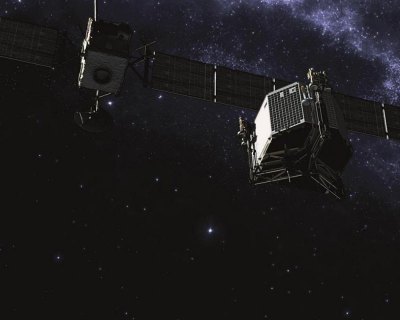European spacecraft 'sniffs' comet atmosphere

Artist's concept of Rosetta spacecraft and lander. Image: ESA.
As it turns out, Rosetta is giving the world its money's worth.
The Philae lander has drilled, hammered and studied a mammoth comet more than 300 miles from earth. And in the process, one of its instruments "sniffed" the atmosphere and detected organic molecules after landing, according to the DLR (the German Aerospace Center).
This is important because scientists believe that as planets evolved comets played a central role. Cometary impacts may have brought much of the water in today's oceans.
The Philae initially had trouble landing and was positioned in an “unplanned location,” according to the ESA. Even so, it worked for 60 hours and sent data back to Earth before its batteries stopped working.
Rosetta launched in March 2004 and traveled 6.4 billion kilometers (more than 3.9 billion miles) through the solar system before arriving at the comet in August of this year. The Rosetta mission landed its Philae probe on a comet, a historic first, on Nov. 12.
In a statement, Ekkehard Kührt, scientific director of the project at the German Aerospace Center, said he was pleased.
"We have collected a great deal of valuable data, which could only have been acquired through direct contact with the comet. Together with the measurements performed by the Rosetta orbiter, we are well on our way to achieving a greater understanding of comets. Their surface properties appear to be quite different than was previously thought."
For one thing, the comet -- 67P/Churyumov-Gerasimenko -- was harder than scientists thought. They were not able to go deep into the surface.
A drilling system was activated, but scientists must analyze the data to determine whether a soil sample was actually examined. They have no information about the quantity and weight of the soil sample.
The Philae is currently in hibernation, but researchers believe that in the summer of 2015 temperatures on the comet could allow the battery to be recharged.
Rosetta is an ESA mission with contributions from its member states and NASA.
Related:
European Space Agency probe lands on comet
Spacecraft to give close-up view of comet
How planets and moons are named

